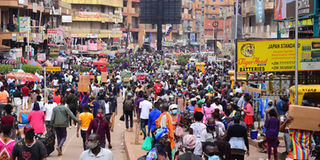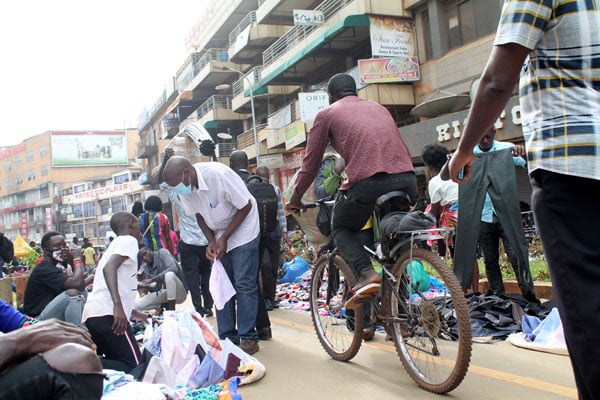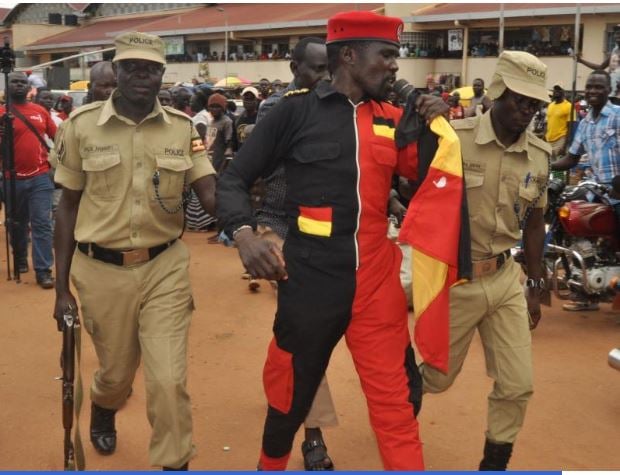Prime
Kampala City’s non-motorised transport fails to take off two years later

Traders and shoppers on Ben Kiwanuka and Luwum streets in downtown Kampala, which is part of the non-motorised corridor. PHOTO/FILE
What you need to know:
- The city authority blames the situation on defiant motorists, and plans to have a sustainable compliance mechanism.
The city’s non-motorised transport (NMT) corridor, which was exclusively created for pedestrians and cyclists, and unveiled to the public in 2019, remains clogged with taxis and boda bodas.
Motorists have in the past two years failed to heed KCCA’s warning against encroaching on the lanes.
The 2km corridor stretches from Entebbe Road via Luwum Street to Namirembe Road and Berkley (Bakuli) junction.
The city authority anticipated that the corridor would allow access to transport opportunities for different income groups, and also allow social inclusion of the vulnerable groups.
However, the plan seems to have hit a snag.
Ms Anita Kusima, the KCCA acting director of physical planning, admitted that some motorists and traders are defiant and have refused to respect the stipulated guidelines for the corridor.
“The project hasn’t failed. It is just that people cannot trade where they are supposed to, and people have no respect for rule of law. The ultimate plan would be to have a sustainable compliance mechanism and also roll out the decongestion exercise, which is already ongoing,” Ms Kusima said.
The NMT route targeted to improve and stimulate travel by sustainable modes (walking and cycling) while providing safe spaces for a highly pedestrianised section of the city.
A recent travel Habit Survey carried out by city authorities shows that walking in the Greater Kampala Metropolitan Area accounts for 46 percent, boda boda 17 percent, taxis 22 percent, cars 13 percent, while others constitute only 2 percent.
Pedestrians make up the largest number of victims of road accidents in and outside Kampala city, according to police crime reports.
Motorists takeover of the corridor could further worsen the situation.
According to the corridor design, the two directional flow of vehicles from Berkeley (Bakuli) to Jaguar bus terminal are allowed.
For the section between Jaguar bus terminal and Pride Theatre, vehicle movement would be restricted to cyclists, while the section of Pride Theatre to Mackay Road (New Taxi Park) and Kisenyi Road is a single lane.
From New Taxi Park to Ben Kiwanuka Street and Burton Street, vehicles would be restricted, while between Burton Street and Entebbe Road, vehicles would be allowed in one direction from Entebbe Road.
Traffic on Ben Kiwanuka Street would cross to the NMT route but with signalised control at Ben Kiwanuka junction.
But taxis would only be allowed at certain hours (between 10pm to 6am) for delivery of goods.
Poor planning?
Motorists noted that the NMT is a good experiment but implemented in a bad place.
For instance, they referred to the taxi parks and bus terminals around the area whose heavy traffic they said spills over to the NMT corridor.
Motorists said the unregulated boda bodas are likely to frustrate this project because most of them don’t have stages.
“The planners should have considered the congestion around that corridor and perhaps implemented it somewhere else. For example, you have the Old and New taxi parks, Namirembe Road Taxi Park, Kisenyi Bus Terminal and the taxi park just off Namirembe Road. So when you close off Namirembe road, it means that traffic will be suffocated and it will definitely spill over. Namirembe and Luwum were a bad choice for this project,” Mr Fred Bagenda, a taxi driver, said.
However, Ms Kusima said the corridor was created on Namirembe-Luwum roads after a successful feasibility study.
She said KCCA is currently considering a holistic framework on reorganising the city’s transport system.
Cyclists accused KCCA of failing to successfully evict errant boda bodas and taxis from lanes meant for cyclists and pedestrians.
“It doesn’t make sense for government to invest heavily in such an infrastructural project and then fail to follow it up. If we can’t freely enjoy our rights on the lanes, then it means the project has failed,” Mr Chrispus Mushabe, a cyclist, said.
Mr Mushabe said taxis and boda bodas have continued to operate in the exclusive lanes because KCCA hasn’t come up with stringent guidelines.
Asked why there is low enforcement against errant boda boda and taxi operators, Ms Kusima said KCCA will continue with the sensitisation sessions until people change their attitude and start appreciating the relevance of infrastructural projects.
While appearing on NTV’s On the Spot talk show in January, Kampala Lord Mayor Erias Lukwago said the city needs non-motorised lanes to cater for other categories of road users.
However, Mr Lukwago said such projects need inclusiveness of all stakeholders who represent interests of all road users instead of working in isolation to avoid future protests like the case is with the NMT corridor.
He said the corridor was hastily implemented without considering the salient issues, which include location, congestion and nature of the city’s transport system.
Way forward
The commissioner of urban administration in the Ministry of Local Government, Mr Justinian Nuwagaba, advised planners in municipalities and cities across the country to involve stakeholders before implementation of development projects as per the planning standards. “I have no jurisdiction over Kampala, but I believe the spirit of having a non-motorised corridor was to allow cyclists to and pedestrians and move uninterrupted. However, the issue of compliance should be dealt with heads-on because urban authorities have always encountered defiant elements and this should be dealt with to ensure development,” he advised.





